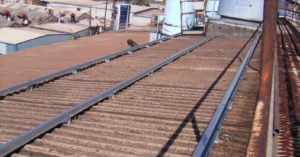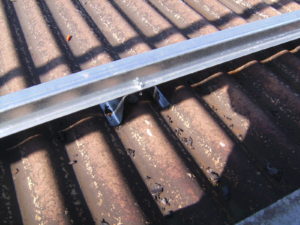As Transite, or Asbestos-containing, Roofs Come to the End of their Life Cycle, Contractors Should Know When Retrofitting Is an Option
The use of asbestos dates back thousands of years. For millennia, cultures across the globe embraced asbestos’ super-strengthening properties. Asbestos’ popularity peaked in the late 19th century during the Industrial Revolution when commercial asbestos mines sprung up across the U.S. and Canada. Before its carcinogenic properties were discovered, asbestos was used in hundreds of applications, including walls, roofs, coatings, fireplaces, shingles, insulation, pipes, furniture, paper products, automobile parts, fabrics and packaging. In the construction industry, in particular, it was considered a “super-product.” Whether mixed as a binder with cement or used as a coating on steel panels, asbestos is insulating, non-combustible, corrosion-resistant, inert, humidity-tolerant and sound absorbent.
One major application of asbestos over the past 100 years has been transite roofing panels. Asbestos was essentially used as a binder in cement slurry and then formed into profiled or flat sheets. Transite roofing panels can still be found across the country; many are still in place after 50, 60 or even 70 years of life. Because transite panels acquired asbestos’ super-strengthening properties, they made (and in some cases continue to make) ideal roofing for foundries, forges, chemical plants, paper plants, wastewater treatment plants and sewage facilities. The roofing material withstands high heat, chemical emissions, humidity and other elements emitted by these facilities that other building products could not tolerate.
Despite the strength of asbestos, even transite roofs can deteriorate or require renovation. In fact, most roofing contractors have encountered or will soon encounter transite roof jobs. The job where transite is in good condition with no airborne particles may be a perfect candidate for a retrofit.
(For the purposes of simplicity, this article uniformly refers to corrugated, asbestos-containing cement roofing sheets as transite. Professionals may also encounter names like 4.2 cement asbestos or corrugated cement. It’s important to note not all corrugated cement roofing sheets contain asbestos; some manufacturers substituted wood fibers for asbestos during the height of asbestos panic in the 1980s. Few of these products successfully penetrated the market because performance did not match that of original transite.)
Leave It In Place
Contrary to popular belief, asbestos is still legally used in many commercial applications in the U.S. today, including roofing and flooring materials; in fireproofing; and in friction products, like brake shoes and clutches.
With the surge of installation of transite roofs in the 1950s and 60s, the lifespan of many of these roofs’ components is just now ending. Common factors attributing to roof or structure deterioration may include longitudinal cracks along the panel highs, broken or brittle fasteners or washers, friable panel material, and/or building shifts due to expansion or contraction. Additionally, other renovations on a building may require that old roofs that are still intact be brought up to new codes.

In the past, abatement through removal was the recommendation of many asbestos professionals. Traditionally, transite was replaced with fiberglass. This solution is imperfect, however, because of the expenses of asbestos removal and new fiberglass, as well as the lower heat tolerance of fiberglass-based materials. More recently, approaches have changed and several other options present themselves.
Today, a good general rule about asbestos (and in fact the position of the Washington, D.C.-based U.S. Environmental Protection Agency) is “leave it on if you can,” meaning it must be in good condition with no airborne particles. Although not always possible, when the contractor can leave the asbestos-containing material in place, asbestos should be considered friend, not foe. Regulations might prevent installation of a new asbestos transite roof, but old buildings that can keep their transite roofs in place will continue to reap the benefits of the product’s super-strengthening properties.

